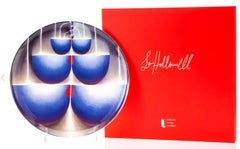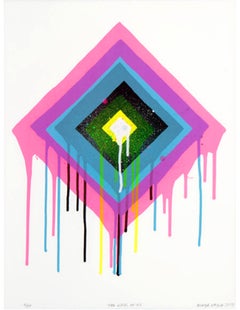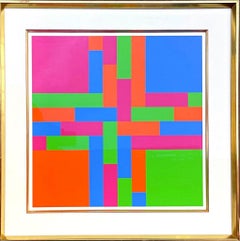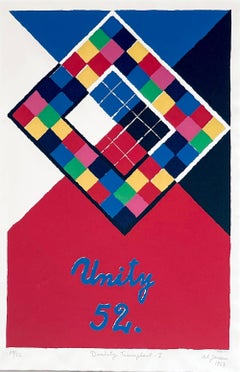Want more images or videos?
Request additional images or videos from the seller
1 of 10
Massimo Vignelli Melting Pot Flag, 19761989
1989
Price:$5,500
About the Item
About the Seller
5.0
Platinum Seller
Premium sellers with a 4.7+ rating and 24-hour response times
Established in 2007
1stDibs seller since 2022
461 sales on 1stDibs
Typical response time: 2 hours
Authenticity Guarantee
In the unlikely event there’s an issue with an item’s authenticity, contact us within 1 year for a full refund. DetailsMoney-Back Guarantee
If your item is not as described, is damaged in transit, or does not arrive, contact us within 7 days for a full refund. Details24-Hour Cancellation
You have a 24-hour grace period in which to reconsider your purchase, with no questions asked.Vetted Professional Sellers
Our world-class sellers must adhere to strict standards for service and quality, maintaining the integrity of our listings.Price-Match Guarantee
If you find that a seller listed the same item for a lower price elsewhere, we’ll match it.Trusted Global Delivery
Our best-in-class carrier network provides specialized shipping options worldwide, including custom delivery.You May Also Like
Derrynan IV (Artist's Proof) - Early Digital Artist
By Harold Cohen
Located in London, GB
A fantastic signed and framed screenprint by Harold Cohen, credited as one of the first digital artists. Derrynan IV features in the Tate collection.
Year: 1967
Framed size: 75.5cm...
Category
1960s Abstract Abstract Prints
Materials
Screen
$2,237 Sale Price
20% Off
H 29.73 in W 29.73 in
Erebos
Located in Miami, FL
Gerd Leufert
Title: Erebos
Signed, titled, dated ‘91 and inscribed P/A in pencil (lower center)
Screenprint on paper
23⅝ by 22⅜ in. / 60 by 56.8 cm.
Executed in 1991, this work is an artist’s proof from an edition of 35 plus 1 artist’s proof.
Provenance: Private Collection, Venezuela - Acquired from the above by the present owner - Sotheby's Auction
“The first duty of the creator: restlessness,” Gerd Leufert wrote in 1985, looking back on his 30-year career as an artist, designer, museum worker, and professor of art in Venezuela.1 Bridging the worlds of commerce and culture in Caracas, Leufert’s impact on art and design owed to his interdisciplinary approach: the influence of cutting-edge developments in abstract art appeared in his graphic design, while the efficiency and bold contrast of mid-century design characterized his paintings.
An immigrant born in German-controlled Lithuania at the cusp of the first World War, Leufert studied arts and design in Hannover, Mainz, and, finally, in Munich with the German typographer Fritz H...
Category
1990s Abstract Geometric Abstract Prints
Materials
Screen
Serie Madrid B, 1990
By Jesús Rafael Soto
Located in Miami, FL
Jesus Soto (1923-2005)
Serie Madrid B, 1990
Denise Rene Editeur, Paris (with Denise Rene's blind-stamp)
Screen print in heavy paper
59 x 45.3 in (150 x 115 cm)
Professionally framed...
Category
1960s Abstract Geometric Abstract Prints
Materials
Screen
Serigrafie di A. Calderara, "Tre tempi a modulo quadrato: ventun frequenze" 1974
By Antonio Calderara
Located in Vicenza, VI
L’opera raccoglie tre fascicoli, con titolo impresso sulla copertina, riuniti in una custodia nera. Al suo interno si trovano sette serigrafie originali di Antonio Calderara, accompa...
Category
20th Century Abstract Abstract Prints
Materials
Screen
$2,702
H 13 in W 13 in D 0.04 in
Telemagisch, 1969, Color Silkscreen, Signed and Limited, Artist Group Zero
By Otto Piene
Located in Eltville am Rhein, DE
Otto Piene
Laasphe 1928 - 2014 Berlin
Telemagisch, 1969
Color silkscreen print
Sheet size: approx. 62 x 42 cm
Signed and dated in pencil lower right
Limited edition 46/100 lower lef...
Category
1960s Abstract Abstract Prints
Materials
Screen
$1,151
H 24.41 in W 16.54 in
Roy Ahlgren 'Allegro' Signed Limited Edition Serigraph Print
By Roy Ahlgren
Located in San Rafael, CA
Roy Ahlgren
Allegro, 1986
Serigraph
Signed, title and edition in pencil in lower margin
Edition 5/100
Sheet: 22 1/4in H x 29 3/4in L (unframed)
Ahlgren came to art relatively late ...
Category
Late 20th Century Abstract Abstract Prints
Materials
Archival Paper, Screen
$263 Sale Price
24% Off
H 22.25 in W 29.75 in D 0.02 in
Christopher Wool 'Untitled' Abstract Expressionist Signed and Numbered Print
By Christopher Wool
Located in San Rafael, CA
Christopher Wool (b. 1955)
Untitled, 2006
Screenprint in colors on Rives BFK paper
30 x 22 inches (unframed)
P.P. 2/4 (A printer's proof aside from an edition of 40)
Signed, numbered...
Category
Early 2000s Abstract Expressionist Abstract Prints
Materials
Screen
Magic Rainbow II, Limited Edition Signed Print
By Yaacov Agam
Located in San Rafael, CA
Yaacov Agam (b. 1928)
Magic Rainbow II, late 20th century
Screenprint in colors on wove paper
LXIII/XC (edition 63/90)
Signed and numbered in pencil along lower edge
13 x 15...
Category
Late 20th Century Abstract Geometric Abstract Prints
Materials
Screen
I-S #1 /// Abstract Geometric Sewell Sillman Screenprint Purple Pink Modern Art
By Sewell Sillman
Located in Saint Augustine, FL
Artist: Sewell Sillman (American, 1924-1992)
Title: "I-S #1"
*Signed and dated by Sillman in pencil lower right
Year: 1968
Medium: Original Screenprint on unbranded heavy white wove ...
Category
1960s Abstract Geometric Abstract Prints
Materials
Screen
Variant III /// Bauhaus Abstract Geometric Minimalism Josef Albers Screenprint
By Josef Albers
Located in Saint Augustine, FL
Artist: Josef Albers (German-American, 1888-1976)
Title: "Variant III"
Portfolio: Ten Variants
*Unsigned edition
Year: 1967
Medium: Original Screenprint on Rives BFK paper
Limited ed...
Category
1960s Abstract Geometric Abstract Prints
Materials
Screen
More From This Seller
View AllCascade (Fine bone china plate, new in bespoke box, Limited Edition of 175)
By Loie Hollowell
Located in New York, NY
Loie Hollowell
Cascade, for Coalition for the Homeless, 2020
Fine bone china in red gift box
10 3/4 in diameter
Edition of 175
Signed in plate, Artists ...
Category
2010s Abstract Abstract Prints
Materials
Porcelain, Screen, Mixed Media, Board
The Likes of Us
By Maya Hayuk
Located in New York, NY
Maya Hayuk
The Likes of Us, 2017
Screenprint with spray paint in colors on Arches paper
Signed, numbered 91/100, dated, and titled in pencil along lower edge. Accompanied by COA hand signed by the artist.
20 × 15 inches
Unframed
This work is accompanied by a Certificate of Authenticity from the artist. Excellent condition.
Published by the artist; Printed by Haven Press, Brooklyn, New York
More about Maya Hayuk:
Maya Hayuk is a Ukrainian-American artist with an extensive background in a wide range of generative art and social practices. Hayuk weaves visual information from her immediate surroundings into elaborate, painterly abstractions, thus creating an engaging mix of referents from popular culture and advanced painting practices alike. Her large-scale, improvised murals speak to the artist’s obsession with symmetry, “perfect imperfection” and outer/ inner space. Her works look to expanding consciousness and perception to find patterns and interconnectivity. Ultimately, the traditional and the contemporary blend into new harmonic, dissonant, optimistic, experimental compositions. Hayuk considers her studio painting and mural practices as both inversely relational and symbiotic.
Hayuk’s work has been the subject of one person exhibitions and commissions at venues including FRAC Museum in Dunkerque, FR (2019), The Ukrainian Museum New York (2017), The Bowery Wall, NY (2014), The Hammer Museum, LA (2013), The Museum Of Contemporary Canadian Art, Toronto, Canada (2013), Bonnefanten Museum, Maastricht, The Netherlands (2012); Socrates Sculpture Park, Queens, New York (2011); Musee E.A.V., Rio De Janiero, Brazil (2011); Matucana Artspace, Santiago, Chile (2009); Democratic National Convention, Denver, Colorado (2008); and Monster Island, Brooklyn, New York (2005-2011). Her work has been included in group exhibitions such as Streetopia, The Luggage Store, San Francisco (2012); Black Light & Outer Space, Secret Project Robot, Brooklyn, New York (2011); Rojo Nova, Museum of Image and Sound, Sao Paolo, Brazil (2010); Contemporary Art 2010, Ukrainian Institute of America, New York (2010); Sous l’es bombs, Musee International des Arts Modeste, Sete, France (2007); The Zine Unbound: Kults, Werewolves, and Sarcastic Hippies, Yerba Buena Center for the Arts, San Francisco, CA (2005).
In 2018, Hayuk gave a TEDx Talk from The Center of Art and Design (CAD) in Brussels, Belgium, which recounts the arc of her developing career.
Maya Hayuk’s work is represented in numerous public and private collections internationally including FRAC Museum (FR), The Ukrainian Museum (US), The Millennium Iconoclast Museum of Art (Brussels, Belgium), The Embassy of the United States of America (Sanaa, Yemen), The Embassy of the United States of America Residence (Costa Rica), MOCA Jacksonville (FL), The Ullens Foundation (Brussels, Belgium), The Dean Collection (US) and Wayne Coyne...
Category
2010s Abstract Geometric Abstract Prints
Materials
Screen, Spray Paint, Mixed Media
Penetration of 4 Interlaced Colour Groups Geometric Abstract Signed/N Silkscreen
Located in New York, NY
RICHARD PAUL LOHSE
Penetration of Four Interlaced Colour Groups (Durchdringung von vier verschränkten Farbgruppen), 1970
Color Silkscreen on velincarton (thin board)
Edition 32/50
P...
Category
1970s Abstract Geometric Abstract Prints
Materials
Screen
Alfred Jensen, Duality Triumphant I, 1963 Signed/N, GE Art Collection, Framed
By Alfred Jensen
Located in New York, NY
Alfred Jensen
Duality Triumphant I (Mid Century Modern Geometric Abstraction), 1963
Color Silkscreen on wove paper
Pencil signed, dated, named and number 19/52 by Alfred Jensen on th...
Category
1960s Abstract Geometric Abstract Prints
Materials
Screen
Cuatro, Monoprint with screenprint collage acrylic, stitching & embossing Signed
By Sam Gilliam
Located in New York, NY
Sam Gilliam
Cuatro, 1994
Monoprint with screenprint, collage, acrylic, stitching and embossing in colors on handmade paper
Hand signed, dated, titled and annotated P/P by Sam Gilliam...
Category
1990s Abstract Expressionist Abstract Prints
Materials
Mixed Media, Acrylic, Monoprint, Screen
Blue/Yellow, SIlkscreen, for New York City Center of Music & Drama, Signed/N
By Jack Youngerman
Located in New York, NY
Jack Youngerman
Blue/Yellow from New York City Center of Music & Drama Portfolio, 1968
Silkscreen on wove paper
Hand signed, dated and numbered 75/144, in graphite by Jack Youngerman...
Category
1960s Abstract Abstract Prints
Materials
Screen



